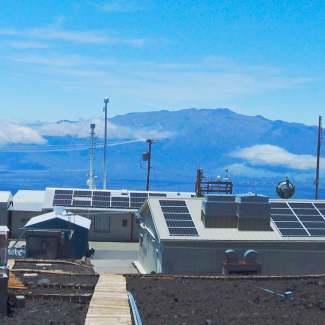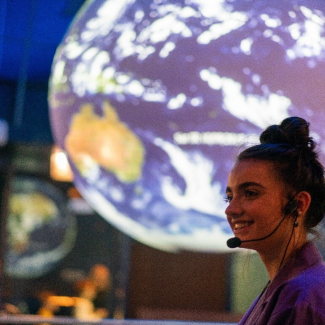How Does Climate Change Affect Natural Resources
Though we often remember about human-induced climate change as something that volition happen in the futurity, it is an ongoing procedure. Ecosystems and communities in the United States and around the world are beingness impacted today.
Global temperatures rose near 1.98°F offsite link (1.one°C) from 1901 to 2020, but climate change refers to more than an increase in temperature. It besides includes sea level rise, changes in weather patterns like drought and flooding, and much more. Things that we depend upon and value — water, energy, transportation, wild animals, agriculture, ecosystems, and human health — are experiencing the effects of a changing climate.
A circuitous issue
The impacts of climate change on different sectors of order are interrelated. Drought tin harm food production and human health. Flooding tin can lead to disease spread and amercement to ecosystems and infrastructure. Human health issues can increase bloodshed, impact nutrient availability, and limit worker productivity. Climate change impacts are seen throughout every attribute of the world nosotros live in. However, climate change impacts are uneven beyond the land and the world — fifty-fifty within a single community, climatic change impacts tin can differ between neighborhoods or individuals. Long-standing socioeconomic inequities tin brand underserved groups, who ofttimes take the highest exposure to hazards and the fewest resource to respond, more vulnerable.
The projections of a climate change-impacted futurity are non inevitable. Many of the issues and solutions offsite link are known to united states now, and ongoing research continues to provide new ones. Experts believe there is yet time to avoid the most negative of outcomes past limiting warming offsite link and reducing emissions to zero as speedily as possible. Reducing our emissions of greenhouse gases will crave investment in new technology and infrastructure, which will spur job growth. Additionally, lowering emissions volition lessen harmful impacts to human being health, saving countless lives and billions of dollars in health-related expenses.

Levels of the two most important anthropogenic greenhouse gases, carbon dioxide and methane, connected their unrelenting ascent in 2020 despite the economical slowdown caused by the coronavirus pandemic response.
Our changing climate
We see climate alter affecting our planet from pole to pole. NOAA monitors global climate information and here are some of the changes NOAA has recorded. You can explore more at the Global Climate Dashboard.
- Global temperatures rose about 1.8°F (1°C) from 1901 to 2020.
- Sea level ascent has accelerated from ane.7 mm/twelvemonth throughout virtually of the twentieth century to iii.2 mm/year since 1993.
- Glaciers are shrinking: boilerplate thickness of xxx well-studied glaciers has decreased more than 60 feet since 1980.
- The area covered by sea water ice in the Arctic at the terminate of summer has shrunk by near forty% since 1979.
- The amount of carbon dioxide in the atmosphere has risen by 25% since 1958, and by about forty% since the Industrial Revolution.
- Snow is melting earlier compared to long-term averages.
Water
Changes to h2o resources can have a large impact on our world and our lives.
Flooding is an increasing issue as our climate is irresolute. Compared to the get-go of the 20th century, there are both stronger and more frequent abnormally heavy atmospheric precipitation events beyond near of the United States.
Conversely, drought is also becoming more than mutual, particularly in the Western U.s.. Humans are using more h2o, especially for agriculture. Much like nosotros sweat more than when it is hot out, college air temperatures cause plants to lose, or transpire, more water, pregnant farmers must give them more water. Both highlight the need for more than water in places where supplies are dwindling.
Snowpack is an important source of freshwater for many people. Every bit the snow melts, freshwater becomes bachelor for utilise, peculiarly in regions like the Western U.s.a. where there is not much precipitation in warmer months. But as temperatures warm, there is less snowfall overall and snow begins to melt earlier in the year, meaning snowpack may non exist a reliable source of h2o for the entire warm and dry seasons.

As Earth heats upwards thanks to human being-caused climate change, scientists expect that wintertime snowpacks volition melt increasingly earlier in the bound.
Food
Our food supply depends on climate and weather condition weather. Although farmers and researchers may be able to adapt some agricultural techniques and technologies or develop new ones, some changes will be hard to manage. Increased temperatures, drought and water stress, diseases, and weather extremes create challenges for the farmers and ranchers who put food on our tables.
Human farm workers can suffer from rut-related health issues, similar exhaustion, heatstroke, and eye attacks. Rising temperatures and heat stress can too harm livestock.
Homo wellness
Climate change is already impacting man wellness. Changes in weather and climate patterns can put lives at risk. Heat is one of the most deadly weather phenomena. Every bit ocean temperatures rise, hurricanes are getting stronger and wetter, which can cause direct and indirect deaths. Dry conditions pb to more wildfires, which bring many health risks. Higher incidences of flooding tin can lead to the spread of waterborne diseases, injuries, and chemic hazards. As geographic ranges of mosquitoes and ticks expand, they can carry diseases to new locations.
The most vulnerable groups, including children, the elderly, people with preexisting health conditions, outdoor workers, people of color, and people with low income, are at an fifty-fifty higher risk considering of the compounding factors from climate modify. Simply public wellness groups can work with local communities to assistance people understand and build resilience to climate change health impacts.

Fries depend on potatoes, and like all crops, potatoes have a preferred climate. How long will America's favorite side dish have a safe spot on our card?
The environment
Climate change will continue to have a significant impact on ecosystems and organisms, though they are not impacted equally. The Arctic is ane of the ecosystems near vulnerable to the furnishings of climate change, every bit it is warming at least twice the rate of the global average and melting land water ice sheets and glaciers contribute dramatically offsite link to sea level ascent around the world.
Some living things are able to answer to climate change; some plants are blooming earlier and some species may aggrandize their geographic range. Simply these changes are happening besides fast for many other plants and animals equally increasing temperatures and changing precipitation patterns stress ecosystems. Some invasive or nuisance species, like lionfish and ticks, may thrive in even more than places because of climate modify.
Changes are as well occurring in the sea. The sea absorbs about 30% of the carbon dioxide that is released into the temper from the burning of fossil fuels. As a result, the water is becoming more acidic, affecting marine life. Bounding main levels are ascension due to thermal expansion, in improver to melting ice sheets and glaciers, putting coastal areas at greater adventure of erosion and storm surge.
The compounding effects of climate modify are leading to many changes in ecosystems. Coral reefs are vulnerable to many effects of climate change: warming waters can lead to coral bleaching, stronger hurricanes tin can destroy reefs, and ocean level ascent tin cause corals to be smothered by sediment. Coral reef ecosystems are domicile to thousands of species, which rely on healthy coral reefs to survive.

Equally time to come leaders who volition make decisions nearly the issues they face in their communities, the Museum of Scientific discipline and Industry positioned high school-anile teens to human action as advocates for building the city's resilience to the impacts and consequences of global climate change.
Infrastructure
Physical infrastructure includes bridges, roads, ports, electrical grids, broadband internet, and other parts of our transportation and communication systems. It is oftentimes designed to be in employ for years or decades, and many communities have infrastructure that was designed without future climate in mind. But fifty-fifty newer infrastructures can be vulnerable to climate change.
Extreme weather events that bring heavy rains, floods, wind, snow, or temperature changes can stress existing structures and facilities. Increased temperatures require more indoor cooling, which can put stress on an energy grid. Sudden heavy rainfall tin lead to flooding that shuts down highways and major business areas.
Nigh 40% of the United states of america population lives in coastal counties, meaning millions of people volition be impacted past sea level ascension. Coastal infrastructure, such as roads, bridges, water supplies, and much more than, is at take a chance. Sea level ascent can also lead to coastal erosion and loftier-tide flooding. Some communities are projected to possibly end up at or below sea level by 2100 and volition face decisions around managed retreat and climate adaptation.
Many communities are not yet prepared to face climate-related threats. Even within a community, some groups are more than vulnerable to these threats than others. Going forrad, it is important for communities to invest in resilient infrastructure that will exist able to withstand future climate risks. Researchers are studying electric current and time to come impacts of climate change on communities and can offer recommendations on best practices. Resilience education is vitally important for metropolis planners, emergency managers, educators, communicators, and all other community members to set up for climate change.

NOAA Sea Grant in North Carolina partnered with state and local groups to evaluate strategies for coping with inland road flooding during tropical storms and hurricanes.
Source: https://www.noaa.gov/education/resource-collections/climate/climate-change-impacts
Posted by: alvarezhourgen39.blogspot.com

0 Response to "How Does Climate Change Affect Natural Resources"
Post a Comment